Welcome to OUR BLOG about the best-growing tips for tomatoes for beginners. Do you OFTEN WONDER how much sun do tomatoes need?
Like all plants tomatoes REQUIRE sunlight to grow and produce fruit. But it is a LITTLE confusing to understand how much sunlight tomatoes need.
Actually, growing tomatoes and sunshine go HAND IN HAND. Without enough light, a tomato plant cannot produce fruit.
And that leaves many gardeners WORRIED about the light requirements of tomatoes.
Still, you don’t need to be anxious because EXPERTS are here to GUIDE you regarding their experience.
Our years of gardening experience allow us to assist you with our EASY and SUITABLE techniques.
After reading this post, you will know how much sun tomatoes need at different stages.
LEARN how much sun do tomatoes NEED and how different types of light affect tomato growth.
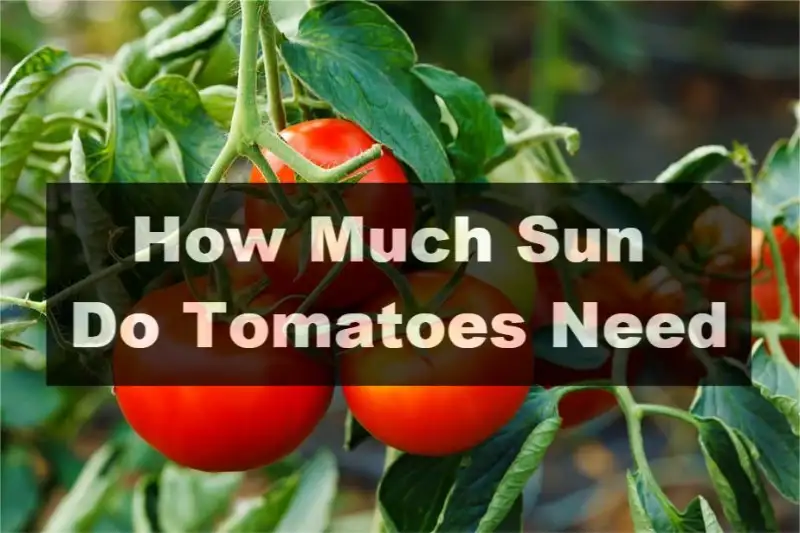
What are the Different Levels of Sunlight and their Effects?
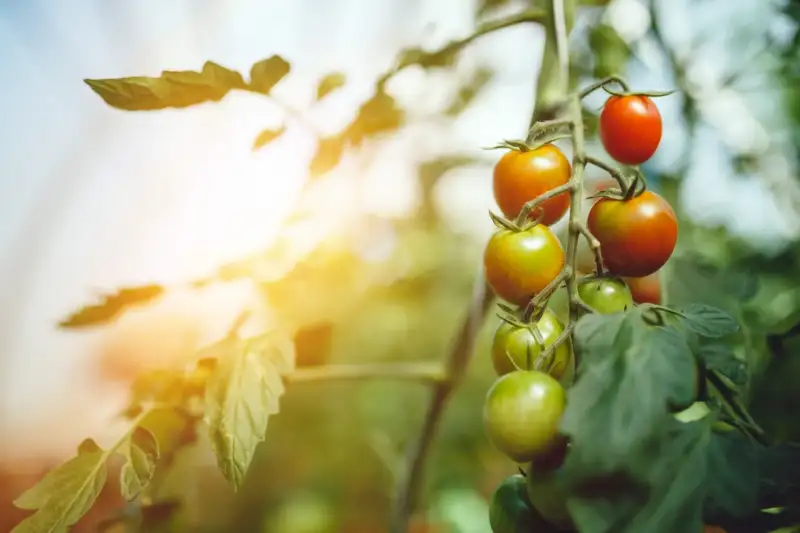
Sunlight is a VITAL energy source and has numerous BENEFICIAL effects on plants.
Plants REQUIRE light to grow. But different levels of sunlight are determined by varying intensities.
Let’s take a look at the various types of sunlight and their effects.
Full Sun
When we USE the term full sun locations, we refer to an open area with no trees to cast shadows.
Want to hear how awesome is this?
This type of sunlight is EXCELLENT for plants that require plenty of direct sunlight.
Direct sunlight is the strongest and more intense type of sunlight.
WELL! It provides the plant with the ENERGY to grow and develop. But if the tomato plant is exposed to TOO MUCH direct sunlight, they become sunburned.
Thus The fruit that develops that way will be sunscald.
Partial Sun
This level of sunlight is quite SIMILAR to partial shade. But both of these still have some differences.
Strange, right?
- Plants that REQUIRE partial sun will tolerate more light.
- Locations with morning or evening sun conditions are ideal for these plants.
- If a tomato receives partial sun exposure, you may NOTICE that some stems are uneven. Or the plant isn’t growing to its projected height.
Partial Shade
Plants that LOVE partial shade could be CONSIDERED as the inverse of partial sun plants.
As opposed to being more TOLERANT to sunlight, they are sensitive. Therefore, PREFER being in the shade of afternoon heat.
Partial shade plants REQUIRE morning or evening shade. It means half-sun and half-shade are appropriate for partial-sun-requiring plants.
Tomatoes planted in these areas will MISS an essential amount of sunlight. Thus won’t grow bigger and stronger to produce many fruits.
Full Shade
Full shade condition REFERS to areas with no FULL sun exposure. Typically it occurs in areas FULLY SHADED by tall buildings or dense trees.
In full-shade conditions, plants struggle for photosynthesis due to the low available light.
It leads to
- Poor growth
- Limited flowering
- Decreased overall health
Thus, it is BETTER to choose shade-tolerant plants to cope with full-shade conditions.
Tomatoes planted in full shade condition will not grow well. They may survive but won’t SEEM HAPPY as in the full sun.
Because of this, they typically grow BETTER in an area receiving some sunlight.
How Much Sun Do Tomatoes Need?
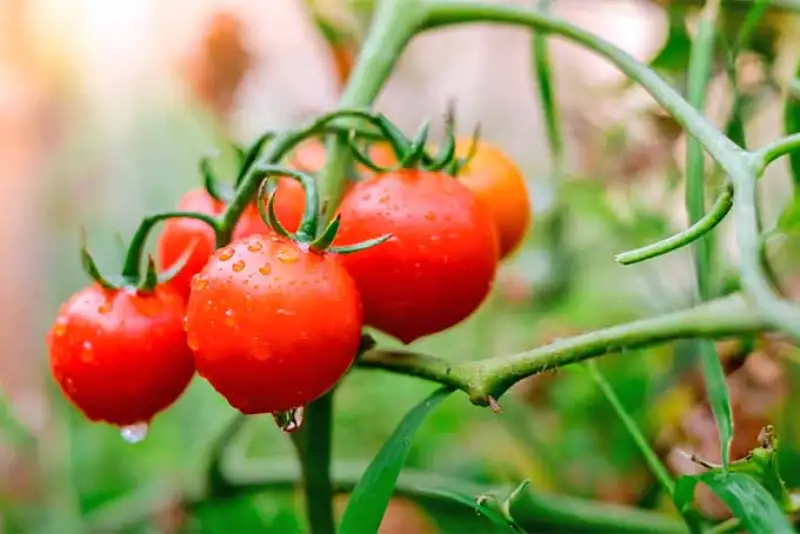
Tomato plants proliferate SWIFTLY. They almost double their mass after every two weeks under suitable conditions.
To MAINTAIN their high growth rate, tomatoes NEED a lot of energy. This energy is produced through photosynthesis in the presence of
- Sunlight
- Water
- Nutrients
So how much sun do tomatoes need? That’s what you are looking for, Right?
Sunlight is an ESSENTIAL element to consider when growing tasty tomatoes. Tomatoes are sun-loving plants that require FULL sun to grow and produce fruit.
Normally, they require at least six hours or as much direct sunlight daily. An increase in an hour or two of the full sun can increase the yield.
Getting my point?
WELL! It is much more complex, though. It is one of the MOST overlooked issues when caring about tomato plants.
The time spent in direct sunlight does not NEED to be consecutive. So if you cannot provide your plant with six hours of direct sunlight, don’t worry about it.
The total direct sunlight RECEIVED must add to give six hours of light to tomato plants.
But while planting tomato plants. You must choose a sunny location that receives full sun for most of the day.
Lack of sunlight CAUSES tomato plants to grow tall and leggy with weak stems and fewer flowers.
But if you are from an area with a hot climate, you must PROVIDE shade during the hottest part of the day.
Sunlight at Different Stages of Growth
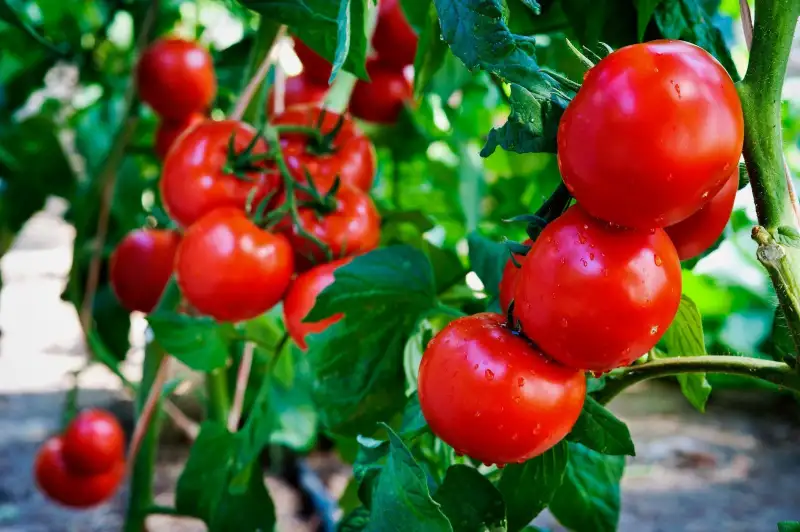
Tomatoes are heliophytes. They require adequate sunlight throughout DIFFERENT STAGES to produce a successful harvest.
The light requirement of a tomato plant CHANGES as it grows from the seedling to the ripening stage.
The different stages of tomato growth and their sunlight requirement are as follows.
Seedling Stage
Tomato seedlings require A LOT of sunlight to grow strong and healthy. But a sunny window will be provided to ENSURE they won’t dry out.
LISTEN! Providing adequate light during the seedling stage will ensure the plant grows.
- Strong stems
- Healthy leaves
- Robust root system
In some cases, tomato plants get TOO MUCH sunlight. Seedlings unprepared for DIRECT sun exposure can suffer from strong sunlight.
Thus, your tomato seedlings NEED some time to get used to outdoor conditions.
It is because the SUDDEN SHOCK of a change in growth factors makes it challenging for them to adjust.
But what can you do in that case?
Gradually give them more exposure to outdoor conditions for a period of several days.
Vegetative Growth Stage
This stage occurs after you have transplanted the seedling.
During vegetative growth, tomato plants GROW rapidly and require plenty of sunlight. The leaves and the vines will become DOUBLE in size after every two weeks.
At this stage, tomato plants NEED A LOT of energy but less than the fruiting.
It requires almost 6-8 hours of direct sunlight daily. As it helps them GROW strong bushy stems and plenty of leaves.
Flowering Stage
Tomatoes ENTER the flowering stage once they are mature and produce enough foliage.
It is the second MOST DELICATE stage and requires controlled exposure to sunlight.
Therefore, a fully UNCOVERED shade cloth with the east and west sides is recommended.
Having such a shade ensures MAXIMUM morning and afternoon sun penetration. But it also protects the flowers from direct heat.
The tomato plant needs at least eight hours of sunlight during the flowering stage.
Inadequate light can lead to POOR flower formation, which results in poor yield.
Fruiting Stage
During the fruiting stage, tomato plants require plenty of sunlight.
As the fruits grow, the plant’s ENERGY REQUIREMENT increases. Thus, they require up to 10 hours of sunlight per day to ripen their fruit.
WELL! Young tomatoes can get sunscald, especially during their growing period. Therefore, if your area has a HIGH TEMPERATURE, it is better to provide shade to your tomatoes. Get this?
At the same time, it is a very HIGH-ENERGY state. Thus, a LACK of sunlight during this stage can lead to
- Slow growth
- Uneven Ripening
- Reduce Yield
Ripening Stage
As the tomatoes mature, there is no additional NEED for nutrients and energy. Thus, the plant doesn’t DEMAND any amount of sunlight. Isn’t that awesome?
The ripening process of tomatoes is CONTROLLED by ethylene gas.
Tomatoes release ethylene gas as they get ripen. It initiates positive feedback that SPEEDS UP the ripening process.
How Different Types of Light Affect Tomato Growth?
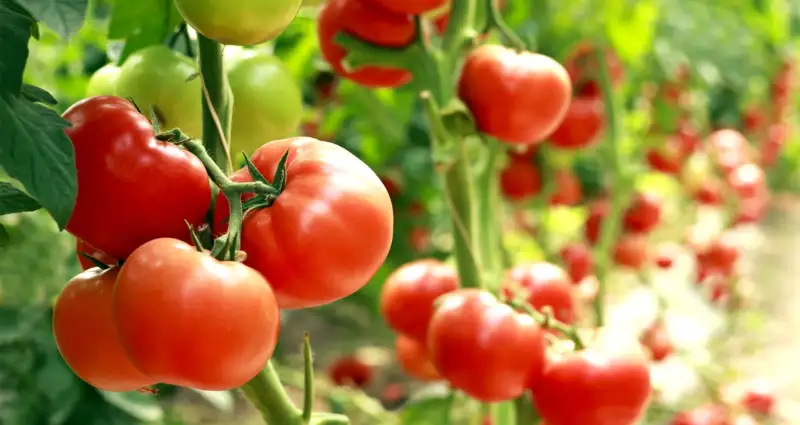
There are different types of sunlight you must be AWARE of if you are growing outdoors.
But before looking into the different kinds of sunlight. You should know that tomato plants need HIGH-INTENSITY light and not HIGH-HEAT intensity.
Getting my point? Aren’t you?
It means while planting tomatoes, you must AIM to maximize the light while minimizing its harmful effects.
It is common to categorize sunlight by the time of the DAY.
Morning Light
Morning light is very BENEFICIAL for plants. It provides the plants with the highest intensity light without any EXCESS heat.
Thus, the morning sun provides the plant with ENERGY. And protect the plant without subjecting it to extreme heat.
The high light intensity and low heat morning light are also PERFECT for the seedlings.
Midday Light
Midday sunlight appears when the sun is OVERHEAD, at its brightest and hottest. That is when the sun is HIGHER, and the plants get a lot of direct sunlight, which they LOVE.
LISTEN!
Unfortunately, this increased light comes along with increased heat. And the high temperature CAUSES problems for the tomato plants.
- Thus, using a shade cloth is a good idea if the temperature rises above 90°F.
- Some gardeners strategically grow sunflowers to provide shade from the midday sun.
In the morning, sunlight is LESS intense but provides a good-intensity light. Contrarily, during midday, tomato plants can EXPERIENCE excessive heat from the sunlight.
Hence, you MUST consider the tradeoff between bright sunlight and excessive heat.
Afternoon Light
Afternoon light appears when the sun has STARTED to set from its overhead position.
It is more INTENSE than the morning n, unlike the midday sunlight.
Here is how it is preferable.
The afternoon sunlight is preferable to the midday sun. It is because it provides light intensity with LOWER heat.
Which is Best?
There are MANY benefits of having different LEVELS of sunlight for plants.
Morning sun benefits are slight. But it can be BENEFICIAL for a plant that needs MORE time with less light during the day.
Direct sun lasts longer than the scattered one and is BETTER for heliophytes.
Pro tip:
It is better to place your tomato plants in a north-south direction. Make sure that nothing could cast shadows on them.
Plants should be oriented toward the east to RECEIVE early morning sunlight.
Methods to Help Tomatoes Withstand the Sun
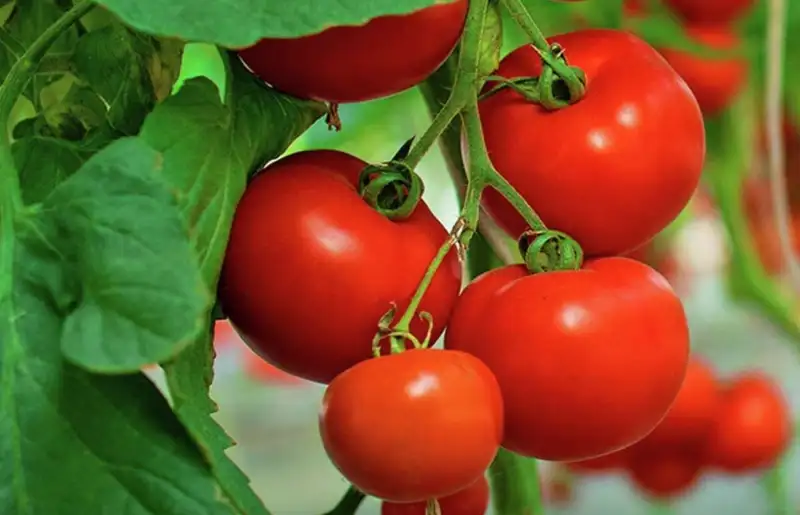
Tomatoes are sun-loving plants that require MUCH sunlight to grow and produce fruit. But, TOO MUCH sun can be harmful to tomatoes, causing damage to the fruit.
Still, there are several methods you can FOLLOW to help tomato plants to withstand enough sun. These include,
Provide Shade
Providing shade is one of the EASIEST ways to help tomato plants withstand the sun.
It can be done using shade cloth or planting a taller plant or tree nearby.
Shade cloth consists of lightweight fabric. That fabric can be used to FILTER sunlight and PROTECT tomatoes from direct sun. It comes in different DENSITIES that provide the right amount of shade for your plant. Cool, right?
Another OPTION is to grow tomatoes that receive shade during the day’s HOTTEST part.
Deep Watering
Tomatoes need CONSISTENT moisture to grow and produce fruit, especially in hot weather.
- So, water your plant profoundly and consistently to keep the soil MOIST.
- Soak the plant in the morning, and don’t water until the soil gets dry.
- Avoid irregular watering and getting wet leaves, as it can cause sunscald.
Mulch
Mulch helps you to REGULATE the temperature and moisture level of the soil. It can help tomatoes to WITHSTAND the sun.
The more mulch you add, the more you can SHIELD the soil from the breeze.
Choose the Right Location
Choose the best location for your plant where it RECEIVES plenty of sunlight. Also where it gets some shade during the hottest segment of the day.
The shade can be provided by
- Trees
- Other plants, or
- Shade cloth
If they are GROWING in a container, consider moving them to a shaded location during the hottest part.
Pruning
- Pruning your tomato plant HELPS to IMPROVE air circulation.
- It REDUCES the amount of foliage exposed to the sun.
- It also helps your plant to PREVENT sunscald and other problems.
So prune your plant’s lower leaves and suckers to ALLOW more sunlight to reach the fruit.
Suggested reading: Soil PH For Tomatoes: Expert Tips To Plant
FAQs about How Much Sun Do Tomatoes Need
1. Which side of the home is best to plant tomatoes?
The best side to plant tomatoes depends on the location and climate. Typically tomatoes NEED about 6-8 hours of direct sunlight daily.
But which side provides your plant with maximum light?
Well! If you live in the northern hemisphere, the southern side PROVIDES plenty of sunlight.
Contrarily, the northern side is BEST if you are in the southern hemisphere.
2. Should you water tomatoes every day in hot weather?
Though tomatoes need consistent watering, watering every day is not NECESSARY.
It is because overwatering can LEAD to root rot.
Water deeply once or twice a week with a LIMIT of about an inch per week.
Adjust your watering limits according to the weather and soil conditions.
3. What temp is too hot for tomatoes?
Tomatoes normally thrive in warm weather and so can TOLERATE high temperatures.
Still, EXTREME heat negatively affects the healthy growth of fruit.
When the temperature RISES above 90°F, tomato plants experience a reduction in the fruit set. Hence resulting in poor fruit quality.
What’s Next
Now you have LEARNED how many hours of sun do tomatoes need.
The light requirement of tomato plants depends on their growing stages. Tomatoes usually require about six to eight or more hours of sunlight.
So plant your tomatoes in an area where they get SUFFICIENT sunlight. But protect them from TOO MUCH sun as it can cause sunscald.
If you want to LEARN more about tomatoes and other fruits, visit AsterGardening.
We ASSURE you that you will find easy gardening techniques HERE. So, if you have any problem, reach out to us.
